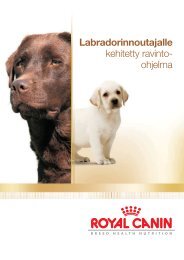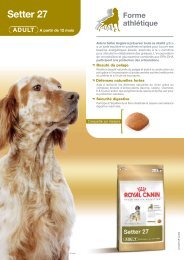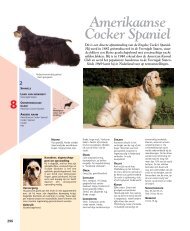Create successful ePaper yourself
Turn your PDF publications into a flip-book with our unique Google optimized e-Paper software.
A Cocker’s external ear canal contains more cerumen*-producing glands than that of any other<br />
breed (Bass, 2004), which increases the risk of maceration. In the event of inflammation these glands<br />
expand and the diameter of the ear canal shrinks, which creates conditions conducive to the appearance<br />
of an infection that causes external otitis (Rosychuk and Luttgen, 2000).<br />
Cockers are also inclined to produce excessive quantities of sebum*, a disease known as seborrhoea*,<br />
which is expressed as greasy skin and dandruff. American Cockers are three times more<br />
likely to contract seborrhoeic dermatitis than the canine population as a whole (Dorn et al, 2001).<br />
Sufferers tend to scratch themselves because seborrhoea creates a favourable canvas for secondary<br />
skin and ear infections, the more so as Cockers are one of the breeds more likely to be affected by<br />
yeast infections, like Malassezia (Bond et al, 1996). The lesions caused by these infectious agents<br />
are most often found around the ears, in the folds around the mouth, between the digits, around the<br />
anus, on the inside of the limbs and on the ventral face of the neck.<br />
English Cocker Spaniel<br />
© J.-M. Labat<br />
Vitamin A responsive dermatitis<br />
This is a rare disease, which is almost exclusively observed in Cockers. Patients present<br />
with dry skin and thick, odorous patches. The skin is greasy, the dog scratches<br />
itself and external otitis is often observed. An in-depth examination will<br />
reveal excessive production of the epidermal cells (hyperkeratosis).<br />
Generally speaking, this complaint responds well to a few weeks’<br />
oral intake of large quantities of vitamin A administered under veterinary<br />
supervision (Gough and Thomas, 2004). The cause of this<br />
problem is unknown, as patients do not generally suffer from dietary<br />
vitamin A deficiency.<br />
The high frequency of chronic<br />
external otitis in Cockers may be<br />
explained by the predisposition of<br />
these dogs to major inflammatory<br />
reactions in the skin and<br />
the excessive production of sebum.<br />
12<br />
© J.-M. Labat
















